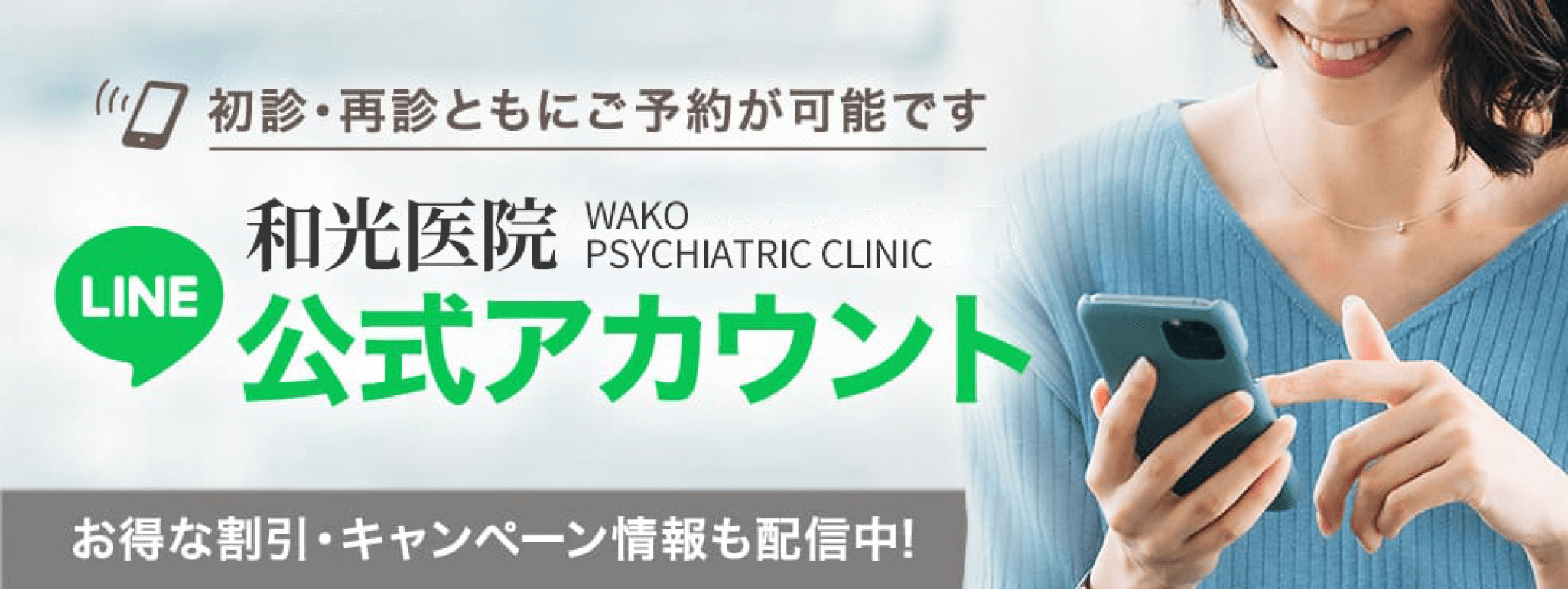ブログ
TMS治療、左前頭前野に対する連続刺激で、強迫性障害に対して有効性は発揮するか?その根拠は?名古屋の児童精神科医が解説
TMS治療、左前頭前野に対する連続刺激で、強迫性障害に対して有効性は発揮するか?その根拠は?名古屋の児童精神科医が解説
こんにちは、名古屋市千種区 児童精神科専門クリニック、医療法人永朋会 和光医院、加藤晃司です。
今回は、TMS治療、左前頭前野に対する連続刺激で、強迫性障害に対して有効性は発揮するか?その根拠は?について解説します。
TMS治療における左前頭前野(DLPFC: Dorsolateral Prefrontal Cortex)への連続刺激は、強迫性障害(OCD: Obsessive-Compulsive Disorder)の治療にも一定の有効性を示します。以下にその根拠とメカニズムを詳細に説明します。
- 強迫性障害(OCD)と左前頭前野の関係
OCDにおける脳の異常
OCDは、前頭皮質-基底核-視床回路(Cortico-Striato-Thalamo-Cortical circuit, CSTC)の過剰な活性化が主な原因とされています。
特に、前頭前野と扁桃体、基底核(尾状核、被殻)との連携異常が、強迫観念や強迫行為を引き起こすと考えられます。
左DLPFCは感情制御や意思決定に関与し、過剰な不安や強迫的な思考を抑制する役割を担います。
左DLPFCの低活動
OCD患者では、左DLPFCの活動低下が報告されており、この領域の活性化を促進することで症状改善が期待されます。
- TMS治療のメカニズム(左DLPFCへの刺激)
(1) 高頻度TMS(10~20Hz)による神経可塑性の促進
高頻度刺激は、左DLPFCの活動を増加させ、機能低下を補正します。
シナプス可塑性(長期増強、LTP)を誘発し、脳内ネットワーク全体の調和を改善します。
(2) 神経伝達物質の分泌促進
高頻度刺激により、セロトニン、ドーパミン、ノルアドレナリンなどの神経伝達物質の分泌が増加。
これにより、不安感の軽減や、強迫的な思考・行動の制御が促されます。
(3) CSTC回路のバランス調整
左DLPFCへの刺激は、前頭前野と基底核の過剰な相互作用を抑制。
扁桃体や基底核からの過剰な信号が緩和され、強迫症状の減少に寄与します。
- 臨床研究による根拠
(1) 左DLPFCへの高頻度TMSの有効性
ランダム化比較試験(RCT)では、左DLPFCへの高頻度刺激がOCD患者の症状を有意に改善する結果が報告されています。
反応率(症状の50%以上改善):20~30%。
寛解率(症状がほぼ消失):10~20%。
(2) 繰り返し治療の効果
1回の治療セッションではなく、1~2か月の継続的な治療が、長期的な症状改善に寄与することが示されています。
(3) 他部位刺激との比較
補足運動野(SMA)への低頻度刺激がOCD治療に有効であることも知られています。
左DLPFCへの高頻度刺激は、不安症状や抑うつ症状の併発例に特に効果的。
- TMS治療の効果を高める要因
(1) 症状のタイプに応じたアプローチ
強迫観念が主症状:左DLPFCへの高頻度刺激が効果的。
強迫行為が主症状:補足運動野(SMA)への低頻度刺激との併用が有効。
(2) 他の治療との併用
薬物療法(SSRI、クロミプラミン)と組み合わせることで、相乗効果が期待されます。
認知行動療法(CBT)とTMSを併用すると、治療効果の持続性が向上。
(3) 刺激パラメータの調整
刺激頻度:10Hz~20Hzの高頻度刺激。
セッション時間:20~40分。
期間:週5回を1~2か月継続。
- TMS治療の利点と限界
利点
非侵襲的で副作用が少なく、薬物治療が難しい患者に適応可能。
他の脳部位(SMA、ACC)への刺激と併用することで、多角的なアプローチが可能。
限界
反応率や寛解率は個人差があり、全ての患者に劇的な改善をもたらすわけではない。
症状の重症度や長期的な治療継続が必要。
- 施術スケジュールの例
初期治療(1~4週目):
左DLPFCに10Hzの高頻度刺激、1日3000パルス、週5回実施。
症状の変化を評価し、必要に応じて調整。
維持治療(5~8週目以降):
週2~3回の刺激に減らし、効果を持続。
他部位との併用:
SMAへの低頻度刺激を追加し、強迫行為の抑制を図る。
まとめ
左DLPFCへの高頻度TMSは、強迫性障害における強迫観念や不安の軽減に有効であることが示されています。その根拠は、DLPFCの機能活性化が脳内ネットワークのバランスを改善し、OCDの根本的な病態(CSTC回路の異常)にアプローチする点にあります。特に、不安症状や抑うつ症状を伴うOCD患者には、左DLPFCへの刺激が効果的です。
ただし、症状のタイプに応じて補足運動野(SMA)など他部位との併用が必要な場合もあり、専門医の診断と治療計画が重要です。
当院ホームページはこちらより
ご予約は公式ライン、ホームページから可能です。
友達追加はこちらから↓
当院インスタグラムはこちら
https://www.instagram.com/wako_iin/
子どものためのメンタルクリニック
医療法人永朋会 和光医院
児童精神科・精神科・心療内科
〒464-0092 愛知県名古屋市千種区茶屋が坂1丁目12番2号
電話 : 052-712-1777
地下鉄名城線「茶屋ヶ坂」駅 1番出口より徒歩3分
地下鉄名城線「砂田橋」駅 1番出口より徒歩10分
TMS Treatment for OCD: Is Repetitive Stimulation of the Left Dorsolateral Prefrontal Cortex (DLPFC) Effective? Evidence Explained by a Nagoya Child Psychiatrist
Hello, I’m Dr. Koji Kato from Nagoya’s Wako Clinic, specializing in child psychiatry under the Eihoukai Medical Corporation.
Today, I will discuss whether repetitive transcranial magnetic stimulation (rTMS) targeting the left dorsolateral prefrontal cortex (DLPFC) is effective for obsessive-compulsive disorder (OCD) and explain the evidence behind this approach.
OCD and the Role of the Left DLPFC
Neurological Basis of OCD
OCD is characterized by hyperactivity in the Cortico-Striato-Thalamo-Cortical (CSTC) circuit, which involves the prefrontal cortex, basal ganglia (caudate nucleus, putamen), and thalamus.
Dysregulation in this circuit leads to intrusive thoughts (obsessions) and repetitive behaviors (compulsions).
Importance of the Left DLPFC
The left DLPFC is crucial for emotional regulation, decision-making, and impulse control.
In OCD, the left DLPFC shows reduced activity, contributing to impaired control over intrusive thoughts and compulsive behaviors.
Mechanisms of TMS on the Left DLPFC
- High-Frequency Stimulation for Enhanced Neuroplasticity
High-frequency rTMS (10–20 Hz) increases activity in the left DLPFC.
It induces long-term potentiation (LTP), promoting synaptic plasticity and enhancing the DLPFC’s ability to regulate the CSTC circuit.
- Modulation of Neurotransmitter Systems
rTMS promotes the release of serotonin, dopamine, and norepinephrine, which are often imbalanced in OCD.
These neurotransmitters play a critical role in mood stabilization and the suppression of intrusive thoughts.
- Restoring CSTC Circuit Balance
Stimulation of the left DLPFC helps reduce excessive communication between the prefrontal cortex and the basal ganglia.
This mitigates the hyperactivity in the CSTC loop, which is a core feature of OCD.
Clinical Evidence Supporting Left DLPFC Stimulation
- Randomized Controlled Trials (RCTs)
Studies have demonstrated that high-frequency rTMS targeting the left DLPFC significantly reduces OCD symptoms.
Response Rates (≥50% symptom improvement): ~20–30%.
Remission Rates (symptoms nearly eliminated): ~10–20%.
- Sustained Benefits with Repeated Sessions
Continuous treatment for 1–2 months has been shown to provide long-lasting symptom relief.
- Comparison with Other Target Sites
Supplementary Motor Area (SMA): Effective for reducing compulsive behaviors.
Left DLPFC: Particularly beneficial for reducing obsessive thoughts and comorbid anxiety or depression.
Factors Enhancing TMS Effectiveness for OCD
- Tailored Stimulation Based on Symptom Profiles
Obsessive thoughts dominant: High-frequency stimulation of the left DLPFC is effective.
Compulsive behaviors dominant: Combining left DLPFC stimulation with low-frequency stimulation of the SMA enhances outcomes.
- Combination with Other Treatments
Medications: Selective serotonin reuptake inhibitors (SSRIs) or clomipramine combined with TMS show additive effects.
Cognitive Behavioral Therapy (CBT): Particularly exposure and response prevention (ERP), synergizes with TMS to improve and sustain results.
- Optimal TMS Parameters
Frequency: 10–20 Hz.
Duration: 20–40 minutes per session.
Schedule: Five sessions per week for 4–8 weeks.
Advantages and Limitations of TMS for OCD
Advantages
Non-invasive: No need for anesthesia or surgical intervention.
Minimal side effects: Compared to medication, TMS has a low side effect profile.
Customizable: Different brain regions can be targeted based on the patient’s symptoms.
Limitations
Varied Response: Not all patients achieve significant symptom relief.
Time-Intensive: Requires multiple sessions over weeks to months.
Cost: TMS can be expensive and may not always be covered by insurance.
Example TMS Treatment Protocol for OCD
Initial Phase (Weeks 1–4)
Target: Left DLPFC.
Frequency: 10 Hz.
Intensity: 3,000 pulses/session.
Schedule: 5 sessions per week.
Maintenance Phase (Weeks 5–8 and beyond)
Schedule: 2–3 sessions per week.
Evaluation: Regular monitoring of symptom changes using standardized scales like the Yale-Brown Obsessive-Compulsive Scale (Y-BOCS).
Combination with Other Targets
SMA stimulation: For patients with prominent compulsive behaviors, add low-frequency (1 Hz) stimulation to the SMA.
Summary
Repetitive TMS targeting the left DLPFC has shown promise as an effective treatment for obsessive-compulsive disorder, particularly for reducing intrusive thoughts and anxiety symptoms. Its efficacy stems from enhancing prefrontal activity, modulating neurotransmitters, and restoring balance in the CSTC circuit.
Best suited for: OCD patients with dominant obsessive thoughts and those resistant to conventional treatments like SSRIs or CBT.
Combination therapy: Enhanced when paired with SMA stimulation, medications, or CBT for comprehensive symptom management.
While TMS offers a promising non-invasive option, individualized treatment planning and regular evaluation by a specialist are essential to maximize its benefits.
受診される方へ
初めて受診される方
当院は予約制をとっておりますが、初診の場合は若干のお時間をいただくこととなり、お待ちいただくことがあります。スムーズにご案内する為に、WEB問診のご利用をおすすめいたします。
WEB問診はこちら >
初診予約は電話にてお願いします。
再診される方
お電話もしくは予約システム(チェック・オン)から予約を取ることもできます。予約の変更や取り消しをご希望の場合には、診療時間内に受付にお電話いただくか、予約システムから変更・取り消しを行ってください。
パソコン・携帯から簡単にご予約できます。
和光医院 診療時間のご案内

【診療時間】
午前 9:00〜13:00
午後 15:00〜18:00
土曜 9:00〜14:00
【休診日】 日・祝日
患者様へのご案内
- 明細書について:当院では、療養費規則に基づき明細書の発行を無料で行っています。
- 一般名による処方について:後発医薬品が存在する場合は、商品名ではなく一般名(有効成分名)で処方することがあります。
- 医療情報の活用について:当院では、安心な医療を提供する為、オンライン資格確認や電子処方箋データ等の情報を活用して診療を行っています。


